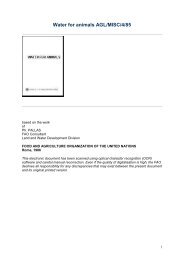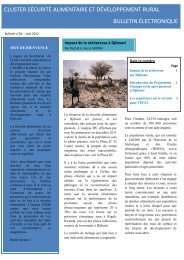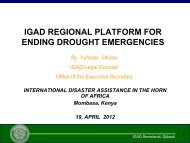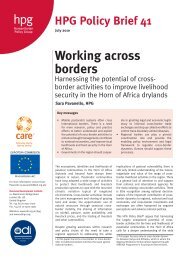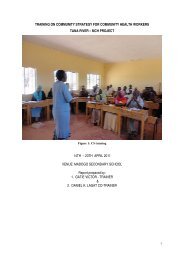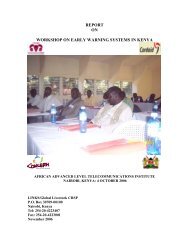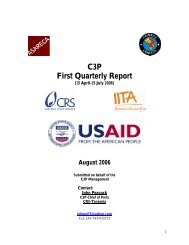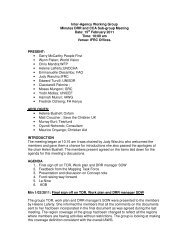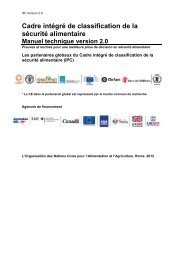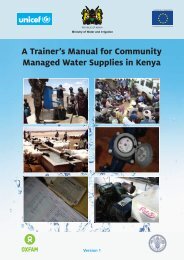However, <strong>the</strong>re are currently no specific coordinati<strong>on</strong> efforts <strong>on</strong> water for productive use orcomm<strong>on</strong> guidelines for water development in pastoral regi<strong>on</strong>s. Water issues are fragmentedbetween different coordinati<strong>on</strong> groups, which are ei<strong>the</strong>r project specific or related to particular<strong>the</strong>mes such as emergency relief, livestock, agriculture/food security, natural resource management,<str<strong>on</strong>g>and</str<strong>on</strong>g> access to safe drinking water, all led by different agencies. The sheer number <str<strong>on</strong>g>of</str<strong>on</strong>g> coordinati<strong>on</strong>groups <str<strong>on</strong>g>and</str<strong>on</strong>g> fora suggests that <strong>the</strong>re is much coordinati<strong>on</strong> but little harm<strong>on</strong>izati<strong>on</strong>. Many <str<strong>on</strong>g>of</str<strong>on</strong>g> <strong>the</strong>existing coordinati<strong>on</strong> efforts touch <strong>on</strong> overlapping <strong>the</strong>mes, are led by different agencies <str<strong>on</strong>g>and</str<strong>on</strong>g> run inparallel. Discussi<strong>on</strong> around water, as a cross-cutting <strong>the</strong>me, is splintered <str<strong>on</strong>g>and</str<strong>on</strong>g> diluted across <strong>the</strong>different groups, <str<strong>on</strong>g>and</str<strong>on</strong>g> where it is a central topic <str<strong>on</strong>g>of</str<strong>on</strong>g> discussi<strong>on</strong> (such as in coordinati<strong>on</strong> fora <strong>on</strong> accessto safe drinking water), discussi<strong>on</strong>s c<strong>on</strong>centrate <strong>on</strong> water for human use ra<strong>the</strong>r than for livestock oragriculture.Box 15: Selecti<strong>on</strong> <str<strong>on</strong>g>of</str<strong>on</strong>g> coordinati<strong>on</strong> efforts relevant to water <str<strong>on</strong>g>and</str<strong>on</strong>g> pastoral development in Ethiopia(based <strong>on</strong> Gijs Van’t Klooster, FAO, <str<strong>on</strong>g>and</str<strong>on</strong>g> Fi<strong>on</strong>a Flintan, ELSE/ELMT Program <str<strong>on</strong>g>and</str<strong>on</strong>g> NRM Technical Working Group,pers<strong>on</strong>al communicati<strong>on</strong>, 2009)Emergency relief:• Overall coordinati<strong>on</strong> <str<strong>on</strong>g>of</str<strong>on</strong>g> emergency interventi<strong>on</strong>s led by UN-OCHA.• Coordinati<strong>on</strong> forum for all PLI-USAID projects (led by Tufts University)*• Coordinati<strong>on</strong> forum for all ECHO RDD projects (led by FAO)*Development:• Coordinati<strong>on</strong> group for <strong>the</strong> Agricultural Growth Programme under <strong>the</strong> Rural Ec<strong>on</strong>omic Development <str<strong>on</strong>g>and</str<strong>on</strong>g> FoodSecurity subgroup <str<strong>on</strong>g>of</str<strong>on</strong>g> <strong>the</strong> D<strong>on</strong>or Assistance Group, led by <strong>the</strong> World Bank. Under this programme, alivestock/pastoral working subgroup has been formed by <strong>the</strong> MoARD, USAID, FAO, Tufts University, <str<strong>on</strong>g>and</str<strong>on</strong>g> <strong>the</strong>European Commissi<strong>on</strong> to promote livestock producti<strong>on</strong> as a vehicle for agricultural growth.• The livestock policy forum (as discussed previously in Secti<strong>on</strong> 3.2.2.1)• Coordinati<strong>on</strong> group for <strong>the</strong> PCDP, led by <strong>the</strong> World Bank• Coordinati<strong>on</strong> group for <strong>the</strong> PSNP, led by <strong>the</strong> World Bank with a taskforce for pastoral areas.Natural Resource Management:• Initially supported under <strong>the</strong> ELSE/ELMT program, <strong>the</strong> NRM Technical Working Group (TWG) currently housedin Save <strong>the</strong> Children/US is made up <str<strong>on</strong>g>of</str<strong>on</strong>g> members from NGOs, government (federal, regi<strong>on</strong>al <str<strong>on</strong>g>and</str<strong>on</strong>g> local), d<strong>on</strong>ors<str<strong>on</strong>g>and</str<strong>on</strong>g> development agencies. It provides a forum for informati<strong>on</strong> <str<strong>on</strong>g>and</str<strong>on</strong>g> experience exchange including, potentially, <strong>on</strong>water. Currently, NRM sub-groups are being established at a regi<strong>on</strong>al <str<strong>on</strong>g>and</str<strong>on</strong>g>/or z<strong>on</strong>al levels.Regi<strong>on</strong>s <str<strong>on</strong>g>and</str<strong>on</strong>g> z<strong>on</strong>es:• Multiple <strong>the</strong>me- based coordinati<strong>on</strong> groups, led by regi<strong>on</strong>al or z<strong>on</strong>al government.*These two have now joined, <str<strong>on</strong>g>and</str<strong>on</strong>g> <strong>the</strong> joint coordinati<strong>on</strong> group is now led by regi<strong>on</strong>al agricultural bureaus.As indicated, guidelines do exist which could serve as a str<strong>on</strong>g foundati<strong>on</strong> for developing a broaderset <strong>on</strong> water for productive use in pastoral regi<strong>on</strong>s. The existence <str<strong>on</strong>g>of</str<strong>on</strong>g> multiple coordinati<strong>on</strong> groupsc<strong>on</strong>cerned with development <str<strong>on</strong>g>and</str<strong>on</strong>g> development-oriented emergency relief in pastoral areas serves asa good opportunity to <strong>the</strong>n mainstream developed guidelines into practice.4.2.3 Water development in <strong>the</strong> c<strong>on</strong>text <str<strong>on</strong>g>of</str<strong>on</strong>g> broader natural resourcemanagementWater in pastoral regi<strong>on</strong>s is part <str<strong>on</strong>g>and</str<strong>on</strong>g> parcel <str<strong>on</strong>g>of</str<strong>on</strong>g> <strong>the</strong> broader natural resource base, <str<strong>on</strong>g>and</str<strong>on</strong>g> decisi<strong>on</strong>srelated to water am<strong>on</strong>g pastoralists are de facto decisi<strong>on</strong>s related to pasture. Therefore watercannot be seen as a st<str<strong>on</strong>g>and</str<strong>on</strong>g>-al<strong>on</strong>e issue <str<strong>on</strong>g>and</str<strong>on</strong>g> water point development for people (<str<strong>on</strong>g>and</str<strong>on</strong>g> livestock) mustalso c<strong>on</strong>sider broader natural resource management if envir<strong>on</strong>mental degradati<strong>on</strong> <str<strong>on</strong>g>and</str<strong>on</strong>g> c<strong>on</strong>flict are tobe minimized.78
However, water development in Ethiopia is still largely worked <strong>on</strong> as a st<str<strong>on</strong>g>and</str<strong>on</strong>g>al<strong>on</strong>e issue divorcedfrom broader natural resource management <str<strong>on</strong>g>and</str<strong>on</strong>g> from broader development. This suggests poorlinkages between water provisi<strong>on</strong> <str<strong>on</strong>g>and</str<strong>on</strong>g> improving livelihood resilience.Some actors have begun to address this disc<strong>on</strong>nect. The government’s PSNP aims to underst<str<strong>on</strong>g>and</str<strong>on</strong>g>customary natural resource use, <strong>the</strong> type <str<strong>on</strong>g>and</str<strong>on</strong>g> extent <str<strong>on</strong>g>of</str<strong>on</strong>g> different natural resources in specific areasincluding degraded l<str<strong>on</strong>g>and</str<strong>on</strong>g>scapes, as well as existing customary resource management systems. It doesso through <strong>the</strong> use <str<strong>on</strong>g>of</str<strong>on</strong>g> participatory natural resource mapping, which allows practiti<strong>on</strong>ers to get a feelfor local needs <str<strong>on</strong>g>and</str<strong>on</strong>g> c<strong>on</strong>cerns. USAID’s PLI uses a similar approach, where Save <strong>the</strong> Children USleads <strong>on</strong> working with <str<strong>on</strong>g>and</str<strong>on</strong>g> streng<strong>the</strong>ning customary instituti<strong>on</strong>s to properly underst<str<strong>on</strong>g>and</str<strong>on</strong>g> localphysical, social, <str<strong>on</strong>g>and</str<strong>on</strong>g> cultural c<strong>on</strong>texts. Some NGOs are doing <strong>the</strong> same. LVIA, as part <str<strong>on</strong>g>of</str<strong>on</strong>g> <strong>the</strong>ELSE/ELMT program, has put toge<strong>the</strong>r a comprehensive GIS based atlas for parts <str<strong>on</strong>g>of</str<strong>on</strong>g> Borana inOromia regi<strong>on</strong>, which identifies existing water resources, water points <str<strong>on</strong>g>and</str<strong>on</strong>g> pasture, am<strong>on</strong>g o<strong>the</strong>rfeatures, to help inform planning. In additi<strong>on</strong>, Oromia regi<strong>on</strong>’s approach to development, through itsOromia Growth Corridors Plan, is to underst<str<strong>on</strong>g>and</str<strong>on</strong>g> existing natural resources <str<strong>on</strong>g>and</str<strong>on</strong>g> l<str<strong>on</strong>g>and</str<strong>on</strong>g> uses through acomprehensive l<str<strong>on</strong>g>and</str<strong>on</strong>g> use mapping <str<strong>on</strong>g>and</str<strong>on</strong>g> planning exercise.4.2.4 Development versus emergency reliefDevelopment projects have begun to put more effort into <strong>the</strong> s<str<strong>on</strong>g>of</str<strong>on</strong>g>tware aspect <str<strong>on</strong>g>of</str<strong>on</strong>g> developmentinterventi<strong>on</strong>s, including working closely with communities to appropriately plan interventi<strong>on</strong>s <str<strong>on</strong>g>and</str<strong>on</strong>g>building local capacity to operate <str<strong>on</strong>g>and</str<strong>on</strong>g> manage schemes. However, development projects <str<strong>on</strong>g>and</str<strong>on</strong>g>programs are dwarfed by much more widespread short-term emergency relief projects. The shortterm nature <str<strong>on</strong>g>of</str<strong>on</strong>g> emergency relief, where projects are typically up to 6 m<strong>on</strong>ths in durati<strong>on</strong> (notexceeding 12 m<strong>on</strong>ths in rare cases), puts inordinate amounts <str<strong>on</strong>g>of</str<strong>on</strong>g> pressure <strong>on</strong> implementing agenciesto address water shortages <str<strong>on</strong>g>and</str<strong>on</strong>g> meet targets at <strong>the</strong> expense <str<strong>on</strong>g>of</str<strong>on</strong>g> appropriate planning <str<strong>on</strong>g>and</str<strong>on</strong>g> ensuringsustainability, which requires much more time 58 . It is not hard to see how <strong>the</strong>se parallel modes <str<strong>on</strong>g>of</str<strong>on</strong>g>operati<strong>on</strong> can undermine l<strong>on</strong>g-term development efforts in <strong>the</strong> rangel<str<strong>on</strong>g>and</str<strong>on</strong>g>s.A nascent trend observed is <strong>the</strong> introducti<strong>on</strong> <str<strong>on</strong>g>of</str<strong>on</strong>g> a l<strong>on</strong>ger term livelihoods approach to humanitarianinterventi<strong>on</strong>s as seen under USAID’s PLI <str<strong>on</strong>g>and</str<strong>on</strong>g> ECHO’s RDD programs (see Secti<strong>on</strong> 3), which focus<strong>on</strong> rehabilitati<strong>on</strong> <str<strong>on</strong>g>and</str<strong>on</strong>g> simple water infrastructure in areas outside settlements. To avoid c<strong>on</strong>tentiousissues related to establishing new water points, such projects increasingly promote rehabilitatingexisting water infrastructure (especially <str<strong>on</strong>g>of</str<strong>on</strong>g> more complex schemes).There are also a number <str<strong>on</strong>g>of</str<strong>on</strong>g> cases <str<strong>on</strong>g>of</str<strong>on</strong>g> NGOs using <strong>the</strong>ir experience with communities in ahumanitarian relief c<strong>on</strong>text as an entry point for l<strong>on</strong>ger term development. For example, OxfamUSA has managed to secure funds for a l<strong>on</strong>g-term development project in pastoral areas focused <strong>on</strong>small-scale irrigati<strong>on</strong>, as a direct follow <strong>on</strong> project building <strong>on</strong> emergency relief activities. Givenincreased funding available for pastoral programs <str<strong>on</strong>g>and</str<strong>on</strong>g> projects, this has meant that <strong>the</strong>re is morelikelihood for follow up projects to take place in pastoral areas, providing some c<strong>on</strong>tinuity (Fi<strong>on</strong>aFlintan 59 , pers<strong>on</strong>al communicati<strong>on</strong>, 2009).Given <strong>the</strong> need for immediate resp<strong>on</strong>se in an emergency c<strong>on</strong>text, it is unlikely that emergency reliefproject cycles will be extended to accommodate <strong>the</strong> time needed to incorporate effective planning<str<strong>on</strong>g>and</str<strong>on</strong>g> o<strong>the</strong>r s<str<strong>on</strong>g>of</str<strong>on</strong>g>tware interventi<strong>on</strong>s which would help improve water point sustainability. In light <str<strong>on</strong>g>of</str<strong>on</strong>g>this, synergies should be promoted between development <str<strong>on</strong>g>and</str<strong>on</strong>g> emergency relief practiti<strong>on</strong>ers to helpmitigate <strong>the</strong> potential for humanitarian interventi<strong>on</strong>s to undermine l<strong>on</strong>g term development.58 It is recommended that planning prior to any new physical interventi<strong>on</strong>s should take about 6 m<strong>on</strong>ths if it isto be d<strong>on</strong>e properly (Warner <str<strong>on</strong>g>and</str<strong>on</strong>g> Abate, 2005).59 Regi<strong>on</strong>al NRM Technical Advisory, ELSE/ELMT Program <str<strong>on</strong>g>and</str<strong>on</strong>g> coordinator NRM Technical Working Group,Addis Ababa79
- Page 1 and 2:
Synthesis
- Page 4 and 5:
TABLE OF CONTENTSLIST OF ACRONYMS..
- Page 6 and 7:
ACKNOWLEDGMENTSI would like to exte
- Page 8 and 9:
LIST OF ACRONYMSACDI/VOCAACFAFDCDDC
- Page 10 and 11:
EXECUTIVE SUMMARYWater development
- Page 12 and 13:
understanding <str
- Page 14 and 15:
Agreed upon guidelines for water de
- Page 16 and 17:
• Make better use of</str
- Page 18 and 19:
to inform their own work an
- Page 20 and 21:
Within pastoral areas, it is recogn
- Page 23 and 24:
Section 2. Overview of</str
- Page 25 and 26:
Dohrn, 2006). Spatially variable ra
- Page 27 and 28: The following broad overview touche
- Page 29 and 30: In areas of adequa
- Page 31 and 32: observed response was for individua
- Page 33 and 34: Specific to water development, seve
- Page 35 and 36: Section 3. Water development todayT
- Page 37 and 38: Eliciting payments for water from l
- Page 39 and 40: ureaus 25 . The ministry’s interv
- Page 41 and 42: National policy paints a conflictin
- Page 43 and 44: will be given to pastoralists to en
- Page 45 and 46: Water supplyGovernance and<
- Page 47 and 48: vulnerable to conversion for other
- Page 49 and 50: • Agro-pastoralists’ priorities
- Page 51 and 52: Although the WSDP principles are se
- Page 53 and 54: The Universal Access ProgramThe Uni
- Page 55 and 56: • Help ensure that public works d
- Page 57 and 58: However, the development model for
- Page 59 and 60: Figure 4: Proposed pilot la
- Page 61 and 62: Many international and</str
- Page 63 and 64: Furthermore, attention is given to
- Page 65 and 66: CARE International, under the GWI,
- Page 67: and traditional me
- Page 70 and 71: • Understand exi
- Page 72 and 73: 4.2 Key observations in the water d
- Page 74 and 75: epresent a firm attempt to preserve
- Page 76 and 77: learning from NGO experiences in Bo
- Page 80 and 81: 4.3 Conclusion, ways forward <stron
- Page 82 and 83: In sum, pastoralism as a livelihood
- Page 84 and 85: • Water interventions selected sh
- Page 86 and 87: • Promote effective participation
- Page 88 and 89: Gebre-Mariam, A. (1982). Organizati
- Page 90: Schimann P. and Ph



